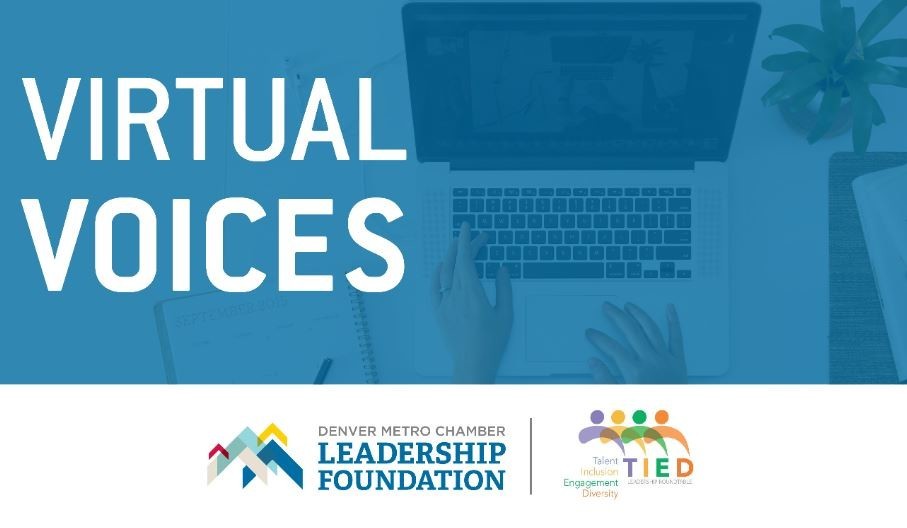The Denver Metro Chamber Leadership Foundation and TIED (Talent, Inclusion, Engagement & Diversity) Roundtable hosted a celebration and discussion on Feb. 17 on the intersectionality of Martin Luther King Jr.’s vision and the internment of Japanese Americans.
Tasha Jones, president and founder of LV Jones Consulting, introduced the discussion. She was joined by meeting facilitator Gloria Neal, public affairs director for the office of Denver Mayor Michael B. Hancock, and speakers Dr. DJ Ida, executive director for the National Asian American Pacific Islander Mental Health Association (NAAPIMHA), and Kwame Spearman, co-owner and CEO of Tattered Cover Book Store.
Check out our key takeaways and the webinar recording below.
Black Americans were one of the first groups to fight for civil rights in the United States, but many races have benefited from Martin Luther King Jr.’s message. Neal said that she looks for intersectionality between cultures in the United States and always seeks to learn about the histories of other groups that have had to fight for their civil rights in doing so. She stressed that civil rights are not just a fight for Black communities but for all discriminated people. Dr. Ida also emphasized that there is no shame in learning about the cultures and histories of other groups, or your own, with time. She noted she did not learn about her own family’s history with Japanese internment camps until she was older, due to the subject never being taught in schools and her family’s feelings of shame around the history. Neal followed this by saying that the work and teachings of Martin Luther King, Jr., have made it possible for this discussion on intersectionality between Black and Japanese cultures in the United States to exist.
What is the significance of Sakura Square to Japanese American culture and history? On Feb. 19, 1942, President Franklin D. Roosevelt passed Executive Order 9066, which forced the relocation of approximately 120,000 Japanese Americans into internment camps. Dr. Ida reflected on the historical significance of this, as Saturday, February 19, 2022, marked the 80th anniversary of this executive order.
As a third-generation American, Dr. Ida said she grew up in Sakura Square, a Japanese American neighborhood in Denver founded by Ralph Carr, Colorado’s governor from 1939 to 1943. Sakura Square began with the Tri-State Denver Buddhist Temple, meant to welcome Japanese Americans and provide a place of racial tolerance and protection of basic rights after they were released from internment camps. Dr. Ida stressed the cultural and historical significance of this square, stating that she chose to headquarter NAAPIMHA in Sakura Square because it represents never forgetting their histories and learning to understand each other.
Every culture has their own traumas and history, and there should be no competition over this. Spearman emphasized this point, saying that while each culture should know its own history and journey, they also should not be afraid to learn about other cultures and their roles in each other’s movements. He said that just a few years ago, many people were researching the Tulsa massacre because, while it may be known in the Black community, others outside the Black community are not aware of this historical event. Similarly, many people do not know the history behind Japanese American internment camps in the United States, and he believes Sakura Square plays a critical role in bringing recognition to this historical event.
What does solidarity look like? Spearman expressed that we live in a time of hyperbole and rampant social media, and that small and nuanced issues get turned into massive wedges that divide communities. He said that while every underrepresented minority has its own unique history, similarities can bring together different cultures, such as feelings of being an outsider, experiencing systemic racism, fear of prejudice and more. Solidarity, to Spearman, is respecting and acknowledging each other’s differences but also taking a macro approach to see the commonalities between experiences.
What about racism and divisions between minority communities? Dr. Ida acknowledged that we cannot pretend there is no racism between minority communities or spaces where people from different backgrounds may not be welcome. While Dr. Ida admitted that minority communities will likely always have certain safe spaces where community outsiders are less welcome, she also said that the key to easing these racial tensions is based on educating ourselves and each other on the histories of other cultures. By learning about their differences and embracing their similarities, as Spearman said, minority communities can come together in powerful ways.
Both Spearman and Dr. Ida agreed that conversations such as Virtual Voices help to engage different cultures and bring them together. They also stressed that supporting each other and educating ourselves on different cultures is key to providing cross-community allyship that will pave the path for future generations to follow.
You can view a list of resources compiled from previous Virtual Voices webinars, and we have started a list of definitions to help frame this and future discussions at Virtual Voices.

